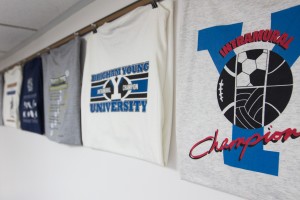The intramural champions shirt is given as the prize for winning either a team or individual event. For some, one victory is enough to brag about. Other students are 15 shirts and counting on their intramural careers.
How do students accomplish the feat of winning multiple intramural shirts? By using a long list of strategies on forming the best teams, playing during certain times and playing certain sports.

BYU Intramural Activities Director Phil Kelly mentioned that there are particular teams that are known for winning four or five times a year. Such success is not unique, as many students make it a personal goal to win as many intramural championships as possible.
Nate Metcalf, a BYU graduate who has won almost 20 shirts, said his best strategy was to start a team with whatever good players he has as friends; he then, each semester, recruits the best athletes from the teams they played against until they had a winning team.
“Most people play with two motives: to play with your buddies or to win. I’ve done both, and they’re both great,” Metcalf said. “But you really have to decide as a team if you’re playing for fun or playing to win. If half the team wants to win and half just wants to play, then no one has a good time.”
Rachel Wade, a student employee at BYU Intramurals, said that during her time there she’s noticed that teams that have past BYU athletes or teams that have played together for a long time in the same sport typically have better chances of winning.
So as BYU students form new teams with the intention of winning an intramural championship, there are a few different strategies they use to optimize the chances of a win.
“Get on a team that has been playing together for a few semesters and knows the sport and the rules really well,” Wade said. “A lot of times, the teams that win are the teams that know all the rules and have developed good strategy for their games.”
One such strategy is choosing what season to play in. The student body drops by nearly two thirds during spring and summer terms, and intramural teams only decrease by two team sports, so statistically speaking, spring and summer are the time to play for a championship.
“There are less teams you’re competing with, but you still have to beat some pretty good teams to get there. But technically the odds are in your favor during spring and summer,” Kelly said.
Maybe it isn’t the time of year you play, but which sport you play that can help win the coveted shirt. Basketball, soccer and football are the most popular, and therefore most competitive sports. They’re followed up by volleyball and softball.
“Basketball has the highest number of teams in competition, but soccer seems to have the most demand. It sells out fastest,” Kelly said.
Metcalf mentioned that most of his wins came from volleyball, although his favorite team was an inner tube water polo team he played on.
“You’re more likely to win in dodgeball or water polo,” Metcalf said. “The most intense athletes make teams in the sports they’ve played, so a lesser-known sport is a bit easier to win in.”
One of those lesser-known sports is the newly added 3v3 soccer that was introduced earlier this summer. It had difficulty gaining traction, but the intramural office expects it to build with word of mouth and have a larger turnout in the future.
“3v3 soccer is, in my opinion, a great addition. I’ve gone out and talked to players, and they’re having a great time. They love the sizing of the fields and the goals,” Kelly said.
Metcalf said he’s heard of some teams that pull dirty tactics out during their quest for intramural victory, like teams that intentionally lose their games to be seated in a lower division or that play with poor sportsmanship. But Kelly said that for the most part, everyone who plays intramurals are honest, clean players who are playing the game the right way.
The rate of intramural athletes who receive sportsmanship cards for bad behavior even once is less than 10 percent. Those who have received more than one sportsmanship card stand at less than one percent; with more than 12,000 students participating, Kelly believes those numbers to be a very good sign of clean play.
Metcalf posited another scenario in which a student can get a shirt. “If you really just want a shirt for the sake of having a shirt, ask a friend with a winning team to let you be on the roster,” Metcalf said. “I’ve had friends do that; sometimes they don’t play much, but they get a shirt.”
For students who want to participate, Kelly imparted his final secret for success on a quest for a shirt: finish “Run for your Life” in winter semester. The 150-mile challenge is the easiest way to win a shirt, in Kelly’s opinion, although of the 500 students who sign up, only 150 finish the challenge.




